Form 8-K DYCOM INDUSTRIES INC For: Mar 06
UNITED STATES
SECURITIES AND EXCHANGE COMMISSION
Washington, D.C. 20549
FORM 8-K
CURRENT REPORT
PURSUANT TO SECTION 13 OR 15(d) OF THE SECURITIES EXCHANGE ACT OF 1934
Date of Report (Date of earliest event reported): March 6, 2018
DYCOM INDUSTRIES, INC. | ||||
(Exact name of Registrant as specified in its charter)
Florida | 001-10613 | 59-1277135 | ||
(State or other jurisdiction of incorporation) | (Commission file number) | (I.R.S. employer identification no.) | ||
11780 U.S. Highway One, Suite 600, | ||||
Palm Beach Gardens, Florida 33408 | ||||
(Address of principal executive offices) (Zip Code) | ||||
(561) 627-7171 | ||||
(Registrant’s telephone number, including area code) | ||||
Check the appropriate box below if the Form 8-K filing is intended to simultaneously satisfy the filing obligation of the registrant under any of the following provisions:
o Written communications pursuant to Rule 425 under the Securities Act (17 CFR 230.425)
o Soliciting material pursuant to Rule 14a-12 under the Exchange Act (17 CFR 240.14a-12)
o Pre-commencement communications pursuant to Rule 14d-2(b) under the Exchange Act (17 CFR 240.14d-2(b))
o Pre-commencement communications pursuant to Rule 13e-4(c) under the Exchange Act (17 CFR 240.13e-4c))
Indicate by check mark whether the registrant is an emerging growth company as defined in as defined in Rule 405 of the Securities Act of 1933 (§230.405 of this chapter) or Rule 12b-2 of the Securities Exchange Act of 1934 (§240.12b-2 of this chapter).
o Emerging growth company
If an emerging growth company, indicate by check mark if the registrant has elected not to use the extended transition period for complying with any new or revised financial accounting standards provided pursuant to Section 13(a) of the Exchange Act. ¨
Item 7.01 Regulation FD Disclosure.
On March 6, 2018, Dycom Industries, Inc. (the “Company”) posted presentation materials in the investor relations section of the Company’s website at http://www.dycomind.com. Members of the Company’s management may use all or portions of these materials from time to time in meetings with or when making presentations to the investment community, current or potential stakeholders and others. The presentation materials are furnished herewith as Exhibit 99.1 and will be available at the Company’s website until Thursday, April 5, 2018.
The presentation materials contain the financial measures of Non-GAAP Adjusted EBITDA, Non-GAAP Adjusted Net Income, Non-GAAP Adjusted Diluted Earnings per Common Share, Non-GAAP Adjusted Diluted Shares, and certain amounts relating to organic contract revenue, which are Non-GAAP financial measures within the meaning of Regulation G promulgated by the Securities and Exchange Commission. Non-GAAP Adjusted EBITDA, defined by the Company as earnings before interest, taxes, depreciation and amortization, gain on sale of fixed assets, stock-based compensation expense, and certain non-recurring items, is not a recognized term under generally accepted accounting principles (“GAAP”) and does not purport to be an alternative to net income, operating cash flows, or a measure of earnings. Non-GAAP Adjusted Net Income is not a recognized term under GAAP and does not purport to be an alternative to GAAP net income. Non-GAAP Adjusted Diluted Earnings per Common Share is not a recognized term under GAAP and does not purport to be an alternative to GAAP diluted earnings per common share. Non-GAAP Adjusted Diluted Shares is not a recognized term under GAAP and does not purport to be an alternative to GAAP diluted shares. Organic contract revenue is not a recognized term under GAAP and does not purport to be an alternative to GAAP contract revenue. Because all companies do not use identical calculations, the presentation of these Non-GAAP financial measures may not be comparable to other similarly titled measures of other companies. The Company believes these Non-GAAP financial measures provide information that is useful to investors because it allows for a more direct comparison of the Company’s performance for the period reported with the Company’s performance in prior periods. A reconciliation of these Non-GAAP financial measures to the most directly comparable GAAP measures is included in Exhibit 99.1.
The information in the preceding paragraphs, as well as Exhibit 99.1, shall not be deemed “filed” for purposes of Section 18 of the Securities Exchange Act of 1934 (the “Exchange Act”), or otherwise subject to the liabilities of that section. It may only be incorporated by reference into another filing under the Exchange Act or the Securities Act of 1933 if such subsequent filing specifically references this Current Report on Form 8-K.
Forward Looking Statements
This Current Report on Form 8-K contains forward-looking statements as contemplated by the 1995 Private Securities Litigation Reform Act. These statements include those related to the outlook for the quarter ending April 28, 2018 and fiscal 2019 and statements related to Non-GAAP financial information referenced in the presentation materials included in this Current Report on Form 8-K. Forward-looking statements are based on management’s current expectations, estimates and projections. These statements are subject to risks and uncertainties that may cause actual results in the future to differ materially from the results projected or implied in any forward-looking statements contained in this Current Report on Form 8-K. The most significant of these risks and uncertainties are described in our Form 10-K, Form 10-Q and Form 8-K reports (including all amendments to those reports) and include business and economic conditions and trends in the telecommunications industry affecting the Company’s customers, fluctuations in customer capital budgets and spending priorities, the adequacy of the Company’s insurance and other reserves and allowances for doubtful accounts, whether the carrying value of the Company’s assets may be impaired, preliminary purchase price allocations of acquired businesses, expected benefits and synergies of acquisitions, the future impact of any acquisitions or dispositions, adjustments and cancellations related to the Company’s backlog, weather conditions, the anticipated outcome of other contingent events, including litigation, liquidity and other financial needs, the availability of financing, the impact of the Tax Cuts and Jobs Act of 2017, and the other risks and uncertainties detailed from time to time in our filings with the Securities and Exchange Commission. These filings are available on a web site maintained by the Securities and Exchange Commission at http://www.sec.gov. The Company does not undertake to update forward-looking statements except as required by law.
Item 9.01 Financial Statements and Exhibits.
SIGNATURES
Pursuant to the requirements of the Securities Exchange Act of 1934, the Registrant has duly caused this report to be signed on its behalf by the undersigned thereunto duly authorized.
Dated: March 6, 2018
DYCOM INDUSTRIES, INC. (Registrant) | |
By: | /s/ Richard B. Vilsoet |
Name: | Richard B. Vilsoet |
Title: | Vice President, General Counsel and Corporate Secretary |

Investor
Presentation
March 2018
Exhibit 99.1

2
Forward Looking Statements, Non-GAAP Financial
Measures and Other Information
This presentation contains “forward-looking statements”. Other than statements of historical facts, all statements contained in
this presentation, including statements regarding the Company’s future financial position, future revenue, prospects, plans and
objectives of management, are forward-looking statements. Words such as “outlook,” “believe,” “expect,” “anticipate,”
“estimate,” “intend,” “should,” “could,” “project,” and similar expressions, as well as statements in future tense, identify
forward-looking statements. You should not consider forward-looking statements as a guarantee of future performance or
results. Forward-looking statements are based on information available at the time those statements are made and/or
management’s good faith belief at that time with respect to future events. Such statements are subject to risks and
uncertainties that could cause actual performance or results to differ materially from those expressed in or suggested by the
forward-looking statements. Important factors, assumptions, uncertainties, and risks that could cause such differences are
discussed in our most recent Annual Report on Form 10-K filed with the Securities and Exchange Commission (“SEC”) on
March 2, 2018, and other filings with the SEC. The forward-looking statements in this presentation are expressly qualified in
their entirety by this cautionary statement. The Company undertakes no obligation to update these forward-looking statements
to reflect new information, or events or circumstances arising after such date.
This presentation includes certain “Non-GAAP” financial measures as defined by Regulation G of the SEC. As required by the
SEC, we have provided a reconciliation of those measures to the most directly comparable GAAP measures on the Regulation G
slides included as slides 29 through 36 of this presentation. Non-GAAP financial measures should be considered in addition to,
but not as a substitute for, our reported GAAP results.

3
Nationwide footprint
Operates in all 50 states, Washington, D.C. and in Canada
Over 40 operating subsidiaries and over 14,000 employees
Strong revenue base, customer relationships and profitable results
Contract revenues of $2.98 billion for the trailing four quarters
ended January 27, 2018
Non-GAAP Adjusted EBITDA of $383.5 million, or 12.9% of revenues
for the trailing four quarters ended January 27, 2018
Non-GAAP Adjusted Diluted EPS of $3.88 for the trailing four
quarters ended January 27, 2018
Solid financial profile
Liquidity of $485.4 million at January 27, 2018, consisting of cash
and availability under our credit facility
No outstanding revolver borrowings at the end of Q2-18
Dycom Overview
See “Regulation G Disclosure” slides 29-36 for a reconciliation of GAAP to Non-GAAP financial measures.
Leading supplier of specialty contracting services to telecommunication providers
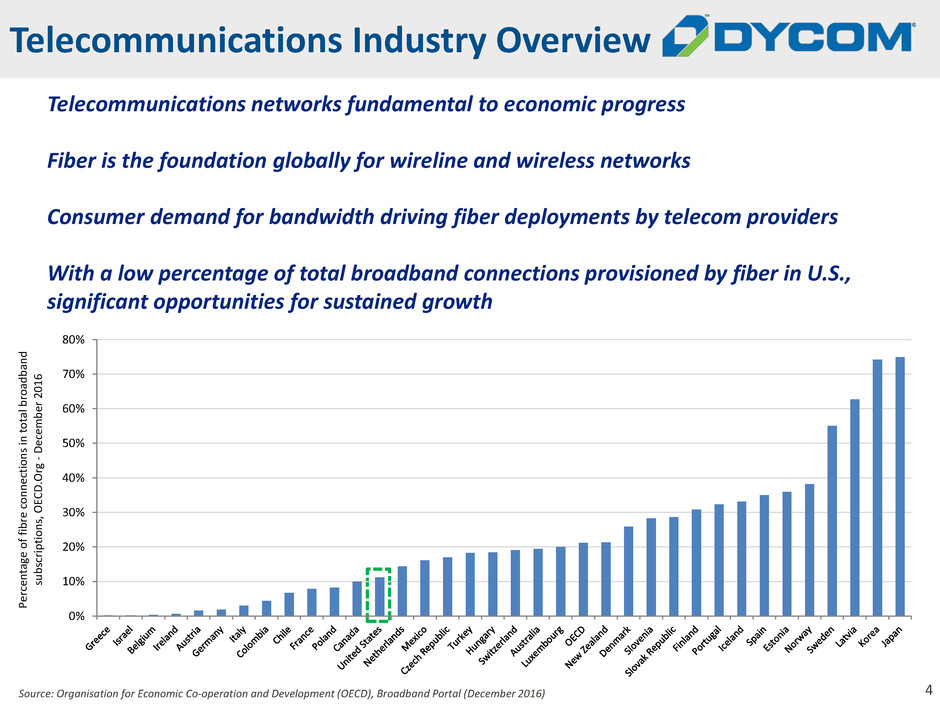
4
Telecommunications networks fundamental to economic progress
Fiber is the foundation globally for wireline and wireless networks
Consumer demand for bandwidth driving fiber deployments by telecom providers
With a low percentage of total broadband connections provisioned by fiber in U.S.,
significant opportunities for sustained growth
Telecommunications Industry Overview
Source: Organisation for Economic Co-operation and Development (OECD), Broadband Portal (December 2016)
0%
10%
20%
30%
40%
50%
60%
70%
80%
Pe
rc
en
tag
e
o
f
fi
b
re
c
o
n
n
ec
tio
n
s
in
t
o
tal
b
ro
ad
b
an
d
su
b
sc
ri
p
tio
n
s,
O
EC
D
.Or
g
-
D
ec
em
b
er
2
0
1
6

5
30 million
0
50
100
150
200
250
2016 Estimate of Homes Passed Homes Available
U.
S.
H
o
m
es
w
it
h
F
ib
er
P
as
si
n
gs
(a
)
(I
n
M
ill
io
n
s)
Massive investment cycle in early stages - total U.S. homes passed with fiber below 20%
(a) Potential of 126.2 million U.S. households (Statista-2017) with estimate that each home will
be passed by two separate telecom providers.
Source: Fiber to the Home Council
188 million
~75% of
homes
commercially
viable for
fiber passing
~250 million
passings (a) Eventual fiber passings estimated to
be approximately 188 million
30 million fiber passings completed
through 2016 - over a decade in
process
Telecommunications Industry Overview
“In an effort to capitalize on the growing demand for our Fioptics suite of products, we expanded our network to reach
70% of the homes and businesses in Greater Cincinnati, making it one of the most dense and competitively
advantaged fiber networks in the country.”
Leigh R. Fox, Cincinnati Bell Inc., President & CEO – February 2018

6
Strong Secular Trend
“IP traffic in North America will reach 85 EB per month by 2021, at a CAGR of 20 percent. Monthly
Internet traffic in North America will generate 11 billion DVDs’ worth of traffic, or 44.7 EB per month.”
“Business IP traffic will grow fastest in North America. Business IP traffic in North America will grow at
a CAGR of 23 percent, a faster pace than the global average of 21 percent.“
Cisco VNI: Forecast and Methodology, 2016–2021 (June 2017)
North America Internet Protocol Traffic vs. GDP Growth
Sources: U.S. Telecom, The Broadband Association; Cisco Visual Networking Index; U.S. National Bureau of Economic Analysis
Strong and stable growth in IP
traffic even in times of GDP decline
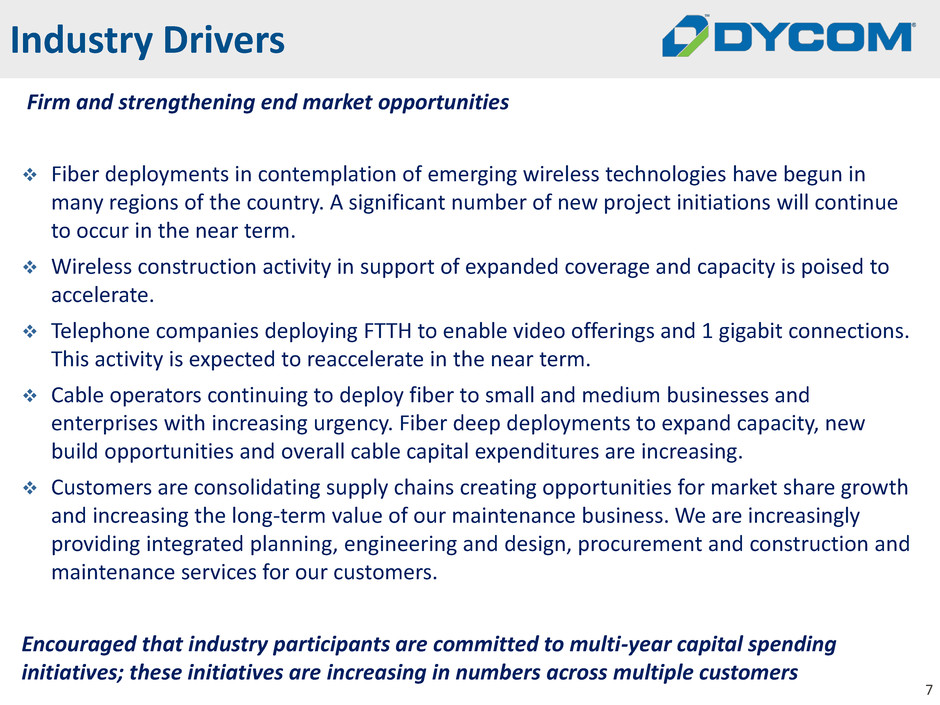
7
Industry Drivers
Firm and strengthening end market opportunities
Fiber deployments in contemplation of emerging wireless technologies have begun in
many regions of the country. A significant number of new project initiations will continue
to occur in the near term.
Wireless construction activity in support of expanded coverage and capacity is poised to
accelerate.
Telephone companies deploying FTTH to enable video offerings and 1 gigabit connections.
This activity is expected to reaccelerate in the near term.
Cable operators continuing to deploy fiber to small and medium businesses and
enterprises with increasing urgency. Fiber deep deployments to expand capacity, new
build opportunities and overall cable capital expenditures are increasing.
Customers are consolidating supply chains creating opportunities for market share growth
and increasing the long-term value of our maintenance business. We are increasingly
providing integrated planning, engineering and design, procurement and construction and
maintenance services for our customers.
Encouraged that industry participants are committed to multi-year capital spending
initiatives; these initiatives are increasing in numbers across multiple customers
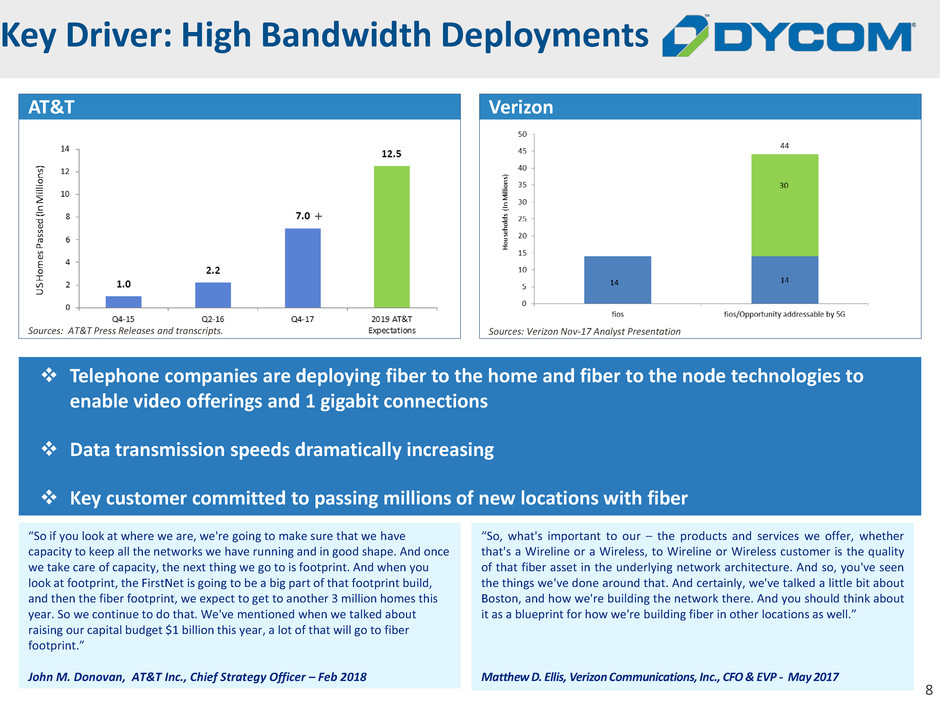
8
Key Driver: High Bandwidth Deployments
“So if you look at where we are, we're going to make sure that we have
capacity to keep all the networks we have running and in good shape. And once
we take care of capacity, the next thing we go to is footprint. And when you
look at footprint, the FirstNet is going to be a big part of that footprint build,
and then the fiber footprint, we expect to get to another 3 million homes this
year. So we continue to do that. We've mentioned when we talked about
raising our capital budget $1 billion this year, a lot of that will go to fiber
footprint.”
John M. Donovan, AT&T Inc., Chief Strategy Officer – Feb 2018
Telephone companies are deploying fiber to the home and fiber to the node technologies to
enable video offerings and 1 gigabit connections
Data transmission speeds dramatically increasing
Key customer committed to passing millions of new locations with fiber
Sources: AT&T Press Releases and transcripts.
AT&T Verizon
Sources: Verizon Nov-17 Analyst Presentation
“So, what's important to our – the products and services we offer, whether
that's a Wireline or a Wireless, to Wireline or Wireless customer is the quality
of that fiber asset in the underlying network architecture. And so, you've seen
the things we've done around that. And certainly, we've talked a little bit about
Boston, and how we're building the network there. And you should think about
it as a blueprint for how we're building fiber in other locations as well.”
Matthew D. Ellis, Verizon Communications, Inc., CFO & EVP - May 2017
+

9
Key Driver: Wireless Network Upgrades
“Mobile connectivity has become essential for many network users. Most people already consider mobile voice
service a necessity, and mobile voice, data, and video services are fast becoming an integral part of consumers
and business users’ lives. Used extensively by consumer as well as enterprise segments, with impressive
uptakes in both developed and emerging markets, mobility has proved to be transformational. The number of
mobile subscribers has grown rapidly, and bandwidth demand for data and video content continues to
increase. Mobile M2M connections represent the fastest growing device/connection category in our forecast.
The next 5 years are projected to provide unabated mobile video adoption. Backhaul capacity and efficiency
must increase so mobile broadband, data access, and video services can effectively support consumer usage
trends and keep mobile infrastructure costs in check.”
Cisco VNI Mobile, 2017
Wireless carriers are increasing 4G capacity
and augmenting 4G with new 5G
technologies creating growth opportunities
in the near to intermediate term
Carriers enhancing coverage and capacity by
increasing the number of small cells
Emerging wireless technologies require
incremental wireline deployments
A complementary wireline investment
cycle is fundamental to applications
enabled by fully converged
wireless/wireline networks
Growth in Number of Cell Sites¹
1 Source: Industry publications
* Compound Annual Growth Rate (CAGR)
0
50,000
100,000
150,000
200,000
250,000
300,000
350,000
400,000
450,000
500,000
2
0
0
0
2
0
0
1
2
0
0
2
2
0
0
3
2
0
0
4
2
0
0
5
2
0
0
6
2
0
0
7
2
0
0
8
2
0
0
9
2
0
1
0
2
0
1
1
2
0
1
2
2
0
1
3
2
0
1
4
2
0
1
5
2
0
1
6
2020
Es
ti
mat
e
s
2025
Es
ti
mat
e
s
U
S
C
e
ll
C
it
ie
s

10
“In business services, we're still in the early stages of bringing our superior products to the large
addressable markets in midsized and enterprise customers.
Brian Roberts, Chairman & CEO, Comcast – January 2018
Key Driver: Fiber to Businesses
1 Calendar 2017
2 Calculated as the combination of the estimated addressable market given by Charter ($20Bn) and Time Warner Cable ($10Bn) in their respective earnings transcripts prior to their May 2016 merger.
Revenue earned by Comcast and Charter from Business Services totaled $12.1 Billion1 of an Addressable
Market of $70 billion
2
Sources: Comcast and Charter Press Releases and transcripts
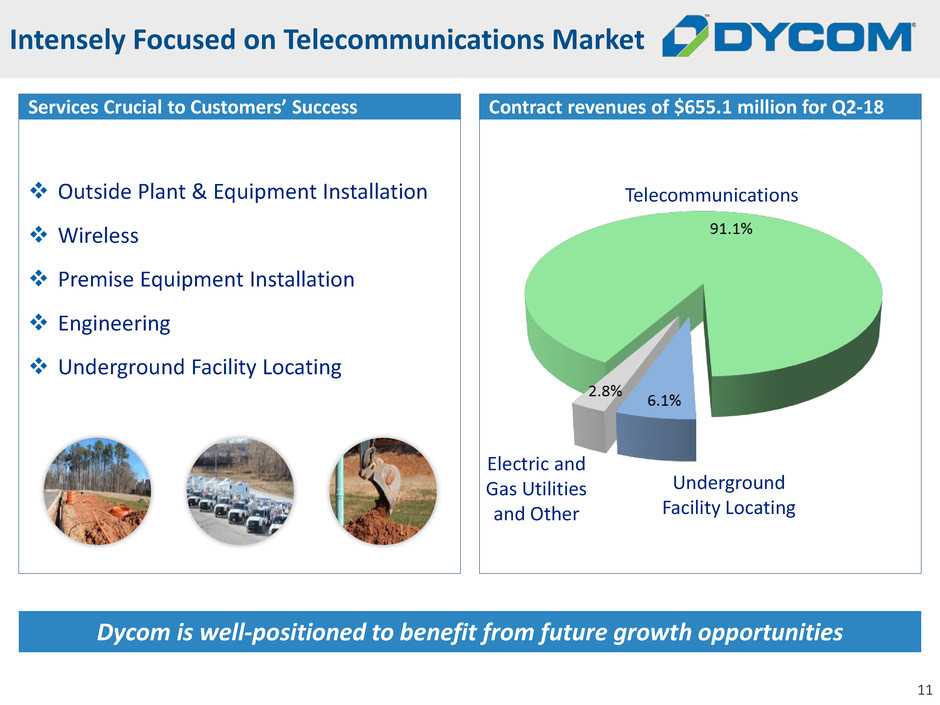
11
Intensely Focused on Telecommunications Market
Contract revenues of $655.1 million for Q2-18 Services Crucial to Customers’ Success
Electric and
Gas Utilities
and Other
Underground
Facility Locating
Telecommunications
Dycom is well-positioned to benefit from future growth opportunities
Outside Plant & Equipment Installation
Wireless
Premise Equipment Installation
Engineering
Underground Facility Locating

12
Local Credibility, National Capability
Subsidiaries Dycom’s Nationwide Presence

13
Focused on High Value Profitable Growth
Anticipate emerging technology trends that drive capital spending
Deliberately target high quality, long-term industry leaders which
generate the vast majority of the industry’s profitable opportunities
Selectively acquire businesses that complement our existing
footprint and enhance our customer relationships
Leverage our scale and expertise to expand margins through best
practices

14
Well Established Customers
Top Customers
Dycom has established relationships with:
Telephone companies
Wireless carriers
Cable multiple system operators
Electric utilities and others
Customer Revenue Breakdown Q2-18
Blue-chip, investment grade customers comprise a substantial portion of revenue
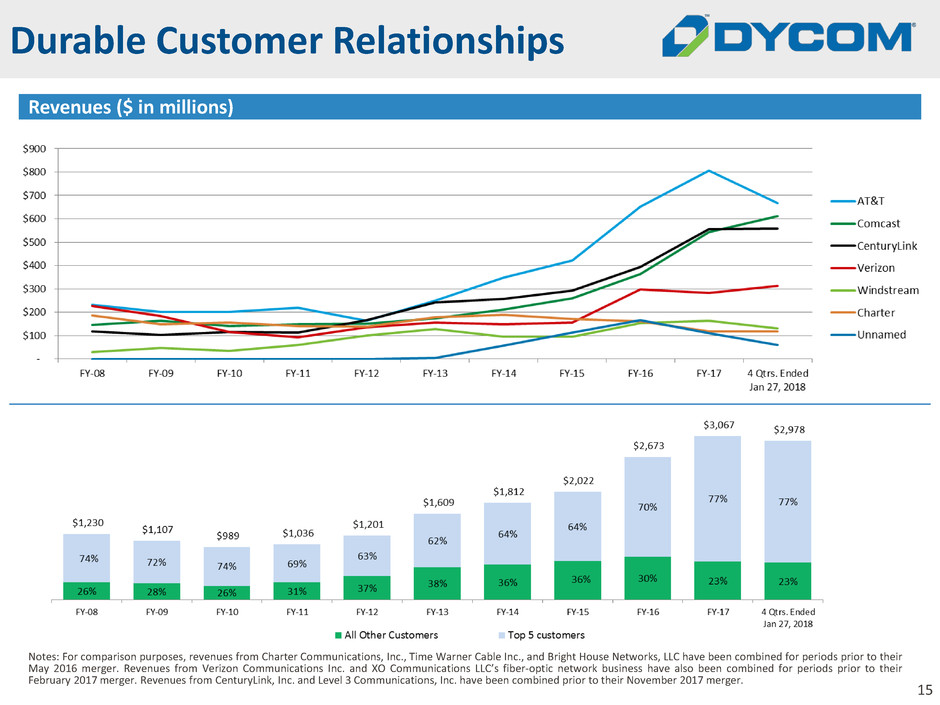
15
Durable Customer Relationships
Revenues ($ in millions)
Notes: For comparison purposes, revenues from Charter Communications, Inc., Time Warner Cable Inc., and Bright House Networks, LLC have been combined for periods prior to their
May 2016 merger. Revenues from Verizon Communications Inc. and XO Communications LLC’s fiber-optic network business have also been combined for periods prior to their
February 2017 merger. Revenues from CenturyLink, Inc. and Level 3 Communications, Inc. have been combined prior to their November 2017 merger.

16
Anchored by Long-Term Agreements
Dycom is party to hundreds of MSA’s and
other agreements with customers that
extend for periods of one or more years
Generally multiple agreements maintained
with each customer
Master Service Agreements (MSA’s)
Multi-year, multi-million dollar
arrangements covering thousands of
individual work orders
Generally exclusive requirement
contracts
Agreements can at times be negotiated
Majority of contracts are based on units
of delivery
Backlog at $5.847 billion as of Q2-18
Revenue by Contract Type for Fiscal Q2-18
Backlog ($ in millions)
Master Service Agreements
Long-term
contracts Short-term
contracts
Our backlog estimates represent amounts under master service agreements and other contractual agreements for
services projected to be performed over the terms of contracts. These estimates are generally based on contract terms
and assessments regarding the timing of the services to be provided. In the case of master service agreements, backlog
is calculated based on the work performed in the preceding twelve month period, when available. When estimating
backlog for newly initiated master service agreements and other long and short term contracts, we also consider the
anticipated scope of the contract and information received from the customer in the procurement process. A significant
majority of our backlog estimates comprise services under master service agreements and other long term contracts.
Backlog is not a measure defined by United States generally accepted accounting principles; however, it is a common
measurement used in our industry. Our methodology for determining backlog may not be comparable to the
methodologies used by others.
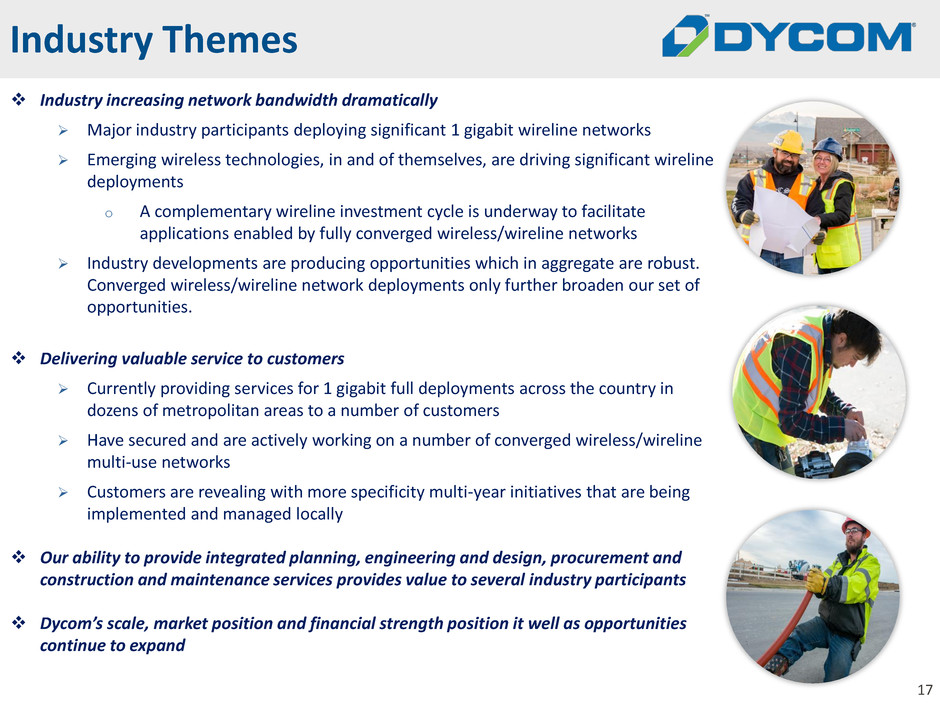
17
Industry Themes
Industry increasing network bandwidth dramatically
Major industry participants deploying significant 1 gigabit wireline networks
Emerging wireless technologies, in and of themselves, are driving significant wireline
deployments
o A complementary wireline investment cycle is underway to facilitate
applications enabled by fully converged wireless/wireline networks
Industry developments are producing opportunities which in aggregate are robust.
Converged wireless/wireline network deployments only further broaden our set of
opportunities.
Delivering valuable service to customers
Currently providing services for 1 gigabit full deployments across the country in
dozens of metropolitan areas to a number of customers
Have secured and are actively working on a number of converged wireless/wireline
multi-use networks
Customers are revealing with more specificity multi-year initiatives that are being
implemented and managed locally
Our ability to provide integrated planning, engineering and design, procurement and
construction and maintenance services provides value to several industry participants
Dycom’s scale, market position and financial strength position it well as opportunities
continue to expand

18
Sources and Uses of Cash ($ in millions)
10+ Years of Robust Cash Flow Generation
Notes: Amounts represent cumulative cash flow for fiscal 2008 – Jan. 2018; See “Regulation G Disclosure” slides as set forth in the Appendix for a summary of amounts. Amounts may not add due to rounding.
Other cash flow includes borrowings, other financing and investing activities and beginning cash on hand.
Strong operating cash flow of
$1.405 billion over 10+ years
Prudent approach to capital
allocation:
$472 million invested in share
repurchases
$597 million invested in
business acquisitions
$899 million in cap-ex, net of
disposals, or approximately 44%
of allocation
Fiscal 2008 – 4 Quarters Ended Jan. 2018
Robust cash flow generation and prudent capital allocation provide strong foundation
for returns
$2,033 $2,033

19
Financial Update
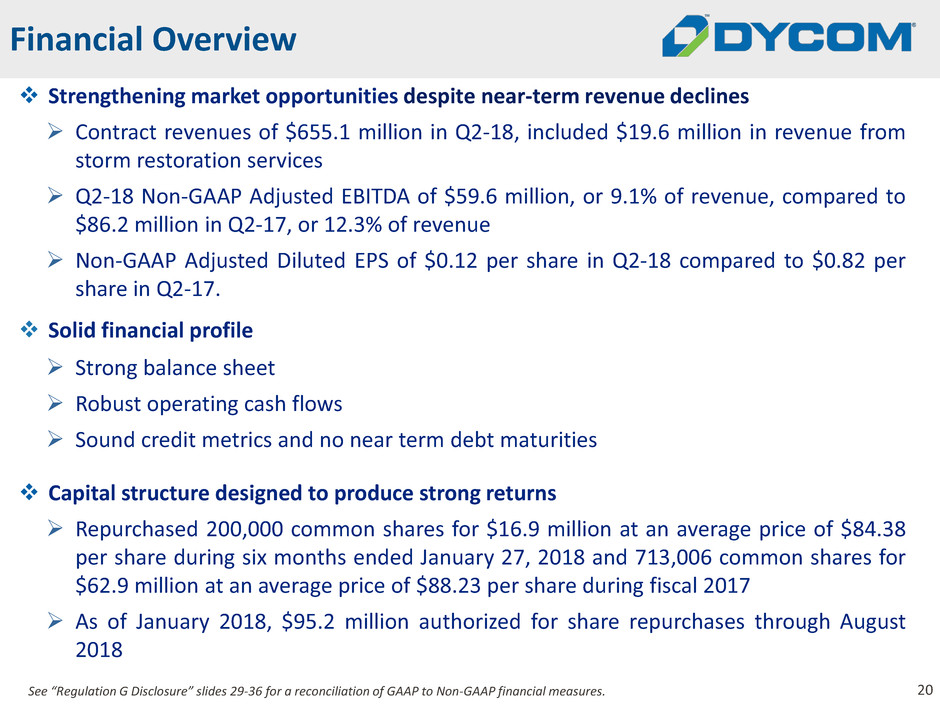
20
Strengthening market opportunities despite near-term revenue declines
Contract revenues of $655.1 million in Q2-18, included $19.6 million in revenue from
storm restoration services
Q2-18 Non-GAAP Adjusted EBITDA of $59.6 million, or 9.1% of revenue, compared to
$86.2 million in Q2-17, or 12.3% of revenue
Non-GAAP Adjusted Diluted EPS of $0.12 per share in Q2-18 compared to $0.82 per
share in Q2-17.
Solid financial profile
Strong balance sheet
Robust operating cash flows
Sound credit metrics and no near term debt maturities
Capital structure designed to produce strong returns
Repurchased 200,000 common shares for $16.9 million at an average price of $84.38
per share during six months ended January 27, 2018 and 713,006 common shares for
$62.9 million at an average price of $88.23 per share during fiscal 2017
As of January 2018, $95.2 million authorized for share repurchases through August
2018
Financial Overview
See “Regulation G Disclosure” slides 29-36 for a reconciliation of GAAP to Non-GAAP financial measures.

21
Contract Revenue Trend
Annual Organic Revenue Trend
Quarterly Contract Revenues
Quarterly Organic Revenue Trend
Annual Growth in Contract Revenues
Financial charts - $ in millions
*Organic % growth adjusted for additional week in Q4-16

22
Non-GAAP Adjusted Diluted EPS
Non-GAAP Adjusted EBITDA Quarterly Non-GAAP Adjusted EBITDA
Quarterly Non-GAAP Adjusted Diluted EPS
Financial charts - $ in millions, except earnings per share amounts
Earnings
See “Regulation G Disclosure” slides 29-36 for a reconciliation of GAAP to Non-GAAP financial measures.

23
Strong balance sheet and robust liquidity
Liquidity and Cash Flow
Financial tables - $ in millions
Balance sheet reflects the strength of our
business
Liquidity of $485.4 million at the end of Q2-18
consisting of availability under our Credit
Facility and cash on hand
Cash Flow from Operating Activities
Robust operating cash flows support strong
organic growth
(a) Availability on Revolver presented net of $48.7 million and $48.6 million L/C’s under the
Senior Credit Facility at Q1-18 and Q2-18, respectively
Liquidity Summary Q1-18 Q2-18
Cash and equivalents $ 24.5 $ 84.0
Senior Credit Facility, matures April 2020:
$450 million revolver $ - $ -
Term Loan Facilities $ 362.9 $ 358.1
Notional Value 485.0 485.0
Total Notional Amount of Debt $ 847.9 $ 843.1
Net Debt (Notional Debt less Cash) $ 823.3 $ 759.0
Total Notional Amount of Debt (see above) $ 847.9 $ 843.1
Unamortized debt discount and debt fees on
0.75% Convertible Senior Notes (87.8) (82.8)
Debt, net of debt discount and fees $ 760.1 $ 760.3
Availability on revolver(a) $ 401.3 $ 401.4
Cash and availability on revolver $ 425.8 $ 485.4
0.75% Convertible Senior Notes, mature September 2021:
*
* Operating cash flows for the trailing 4 quarters ended January 27, 2018
calculated as the aggregate of $42.3 million in Q3-17, $149.9 million in
Q4-17, $56.8 million in Q1-18 and $103.7 million in Q2-18.
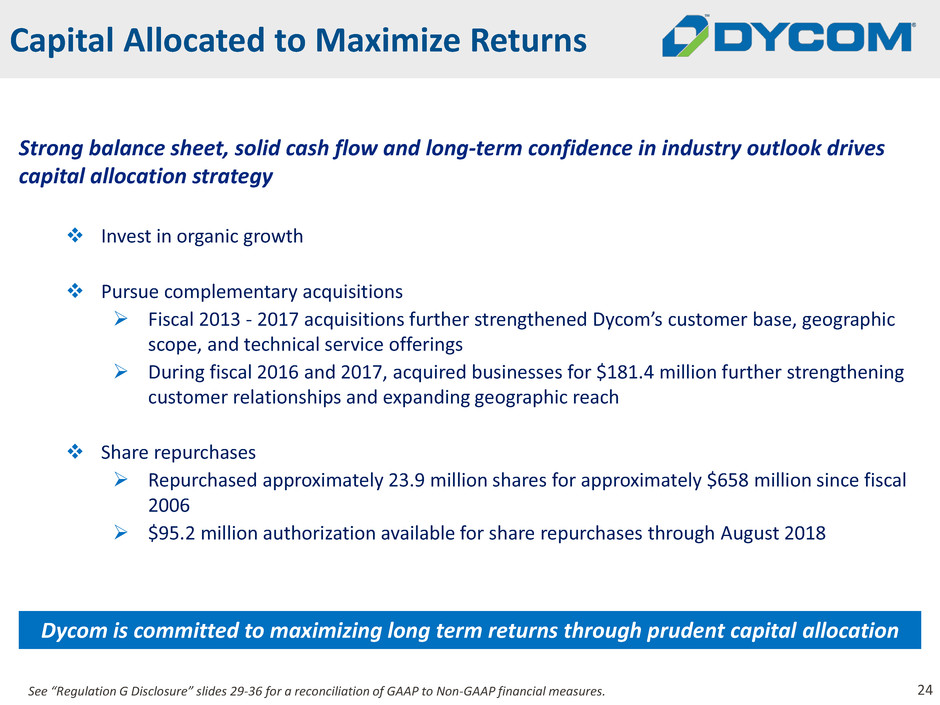
24
Capital Allocated to Maximize Returns
Strong balance sheet, solid cash flow and long-term confidence in industry outlook drives
capital allocation strategy
Invest in organic growth
Pursue complementary acquisitions
Fiscal 2013 - 2017 acquisitions further strengthened Dycom’s customer base, geographic
scope, and technical service offerings
During fiscal 2016 and 2017, acquired businesses for $181.4 million further strengthening
customer relationships and expanding geographic reach
Share repurchases
Repurchased approximately 23.9 million shares for approximately $658 million since fiscal
2006
$95.2 million authorization available for share repurchases through August 2018
Dycom is committed to maximizing long term returns through prudent capital allocation
See “Regulation G Disclosure” slides 29-36 for a reconciliation of GAAP to Non-GAAP financial measures.

Questions
and
Answers

Selected Information
from Q2-18 Dycom
Results Conference
Call Materials
The following slides 27 & 28 were used on February 28, 2018 in connection with
the Company’s conference call for its fiscal 2018 second quarter results and are
included for your convenience. Reference is made to slide 2 titled “Forward-
Looking Statements, Non-GAAP Financial Measures, and Other Information”
with respect to these slides. The information and statements contained in slides
27 & 28 that are forward-looking are based on information that was available at
the time the slides were initially prepared and/or management’s good faith
belief at that time with respect to future events. Except as required by law, the
Company may not update forward-looking statements even though its situation
may change in the future. For a full copy of the conference call materials,
including the conference call transcript, see the Company’s Form 8-Ks filed with
the Securities and Exchange Commission on February 28, 2018 and March 2,
2018.

27 See “Regulation G Disclosure” slides 29-36 for a reconciliation of GAAP to Non-GAAP financial measures.
“Fiscal 2019 Outlook” - This slide was used on February 28, 2018 in connection with the Company’s conference call for its fiscal 2018 second quarter results and are
included for convenience. Reference is made to slide 2 titled “Forward-Looking Statements, Non-GAAP Financial Measures, and Other Information” with respect to
these slides. The information and statements contained in slides 27 & 28 that are forward-looking are based on information that was available at the time the slides
were initially prepared and/or management’s good faith belief at that time with respect to future events. Except as required by law, the Company may not update
forward-looking statements even though its situation may change in the future. For a full copy of the conference call materials, including the conference call transcript,
see the Company’s Form 8-Ks filed with the Securities and Exchange Commission on February 28, 2018 and March 2, 2018.
Trailing 4
Quarters Ended
Jan. 27, 2018
Outlook
Fiscal 2019
Contract Revenues $ 2,978 $ 3,300 - $ 3,500
Diluted Earnings per Common Share – GAAP
$ 4.74 $ 4.78 - $ 5.70
Non-GAAP Adjusted Diluted Earnings per Common
Share
$ 3.88 $ 5.22 - $ 6.14
Non-GAAP Adjusted EBITDA % 12.9% 13.6% -14.1%
Annual Outlook for Fiscal Year Ending January 26, 2019 (Fiscal 2019)
Financial table- $ in millions, except earnings per share amounts (% as a percent of contract revenues, except as noted for Effective Income Tax Rate)
Revenue outlook for Fiscal 2019 reflects our expectations of the following:
Accelerating fiber deployments for emerging wireless technologies
Increasing wireless services
Solid demand from several large customers reflecting 1 gigabit deployments and fiber deep cable capacity projects
Seasonality:
Revenue expected to decline in the April quarter and then increase in the July, October, and January quarters compared to the same
periods in the prior year
Revenue and margins for fiscal 2019 are expected to be impacted by seasonal adverse weather, which is more likely to occur during the
winter season including the fiscal quarters ending in April and January. In addition, a disproportionate percentage of paid holidays fall
within the fiscal quarter ending in January, which decreases the number of available workdays in that quarter.
Trailing 4
Quarters Ended
Jan. 27, 2018
Outlook
Fiscal 2019
Depreciation $ 138.1 $ 160 - $ 164
Amortization $ 24.6 $ 22
Share-based compensation
(Amount is included in General & Administrative
Expense)
$ 23.1 $ 26 – $ 27
Non-GAAP Adjusted Interest Expense
(Excludes non-cash amortization of debt discount
of $18.1 million for Trailing 4 Quarters Ended
Jan. 27, 2018 and $19.1 million for FY-19)
$ 20.6 $ 22 - $ 23
Other Income, net
(Includes gain on sales of fixed assets of $18.9
million for Trailing 4 Quarters Ended Jan. 27, 2018
and expectation of $10 - $12 million in FY-19)
$ 17.1 $ 6 - $ 8
Non-GAAP Adjusted Effective Income Tax
Rate (as a % of Adjusted Non-GAAP Income
before Taxes)
37.0% 27.0 % - 27.5 %
Adjusted Diluted Shares – Non-GAAP 31.8 million 31.9 million
Fiscal 2019 Outlook Other Expectations

28 See “Regulation G Disclosure” slides 29-36 for a reconciliation of GAAP to Non-GAAP financial measures.
“Q1-19 Outlook” - This slide was used on February 28, 2018 in connection with the Company’s conference call for its fiscal 2018 second quarter results and are included
for convenience. Reference is made to slide 2 titled “Forward-Looking Statements, Non-GAAP Financial Measures, and Other Information” with respect to these slides.
The information and statements contained in slides 27 & 28 that are forward-looking are based on information that was available at the time the slides were initially
prepared and/or management’s good faith belief at that time with respect to future events. Except as required by law, the Company may not update forward-looking
statements even though its situation may change in the future. For a full copy of the conference call materials, including the conference call transcript, see the
Company’s Form 8-Ks filed with the Securities and Exchange Commission on February 28, 2018 and March 2, 2018.
Looking Ahead to the Quarter Ended April 28, 2018 (Q1-2019)
Financial table- $ in millions, except earnings per share amounts (% as a percent of contract revenues, except as noted for Effective Income Tax Rate)
Revenue outlook for Q1-2019 reflects our expectations of the following:
Accelerating fiber deployments for emerging wireless technologies
Wireless services begin to ramp
Solid demand from several large customers reflecting 1 gigabit deployments and fiber deep cable capacity projects
Margin outlook for Q1-2019 reflects anticipated timing of activity on large customer programs and the related impacts on margins as well as
near-term weather impacts
Quarter Ended
April 29, 2017
Outlook -
Quarter Ended
April 28, 2018
(Q1-2019)
Contract Revenues $ 786.3 $ 720 - $ 750
Diluted Earnings per Common Share – GAAP
$ 1.22 $ 0.52 - $ 0.67
Non-GAAP Adjusted Diluted Earnings per Common
Share
$ 1.30 $ 0.63 - $ 0.78
Non-GAAP Adjusted EBITDA % 13.8% 10.7% -11.1%
Quarter Ended
April 29, 2017
Outlook -
Quarter Ended
April 28, 2018
(Q1-2019)
Depreciation $ 31.2 $ 37.9 - $ 38.7
Amortization $ 6.2 $ 5.5
Share-based compensation
(Amount is included in General & Administrative
Expense)
$ 4.9 $ 5.3
Non-GAAP Adjusted Interest Expense
(Excludes non-cash amortization of debt discount
of $4.4 million for the Quarter Ended April 29, 2017
and expectations of $4.7 million in Q1-19)
$ 5.0 $ 5.4
Other Income, net
(Includes Gain on sales of fixed assets of $5.0
million for the Quarter Ended April 29, 2017 and
expectation of $4.8 - $5.4 million in Q1-19)
$ 4.8 $ 4.1 - $ 4.7
Non-GAAP Adjusted Effective Income Tax
Rate (as a % of Adjusted Non-GAAP Income
before Taxes)
37.0% 27.0 % - 27.5 %
Adjusted Diluted Shares – Non-GAAP 31.9 million 31.8 million
Q1-19 Outlook Other Expectations

29
Explanation of Non-GAAP Measures
Appendix: Regulation G Disclosure
The Company reports its financial results in accordance with U.S. generally accepted accounting principles (GAAP). In the Company’s quarterly results releases, trend schedules, conference calls, slide
presentations, and webcasts, it may use or discuss Non-GAAP financial measures, as defined by Regulation G of the Securities and Exchange Commission. The Company believes that the presentation of certain
Non-GAAP financial measures in these materials provides information that is useful to investors because it allows for a more direct comparison of the Company’s performance for the period reported with the
Company’s performance in prior periods. The Company cautions that Non-GAAP financial measures should be considered in addition to, but not as a substitute for, the Company’s reported GAAP results.
Management defines the Non-GAAP financial measures used in this trend schedule as follows:
• Non-GAAP Organic Contract Revenues – contract revenues from businesses that are included for the entire period in both the current and prior year periods, excluding contract revenues from storm
restoration services, adjusted independently each comparative period for the additional week in the fourth quarter of fiscal 2016, the quarter ended July 30,2016, as a result of the Company’s 52/53 week
fiscal year. Non-GAAP Organic Revenue growth (decline) is calculated as the percentage change in Non-GAAP Organic Revenues over those of the comparable prior year period. Management believes organic
growth (decline) is a helpful measure for comparing the Company’s revenue performance with prior periods.
• Non-GAAP Adjusted EBITDA – net income before interest, taxes, depreciation and amortization, gain on sale of fixed assets, stock-based compensation expense, loss on debt extinguishment, and certain non-
recurring items. Management believes Non-GAAP Adjusted EBITDA is a helpful measure for comparing the Company’s operating performance with prior periods as well as with the performance of other
companies with different capital structures or tax rates.
• Non-GAAP Adjusted Net Income – GAAP net income before loss on debt extinguishment, non-cash amortization of the debt discount and the related tax impact, certain tax impacts resulting from vesting and
exercise of share-based awards, certain tax impacts of Tax Reform, and certain non-recurring items.
• Non-GAAP Adjusted Diluted Earnings per Common Share and Non-GAAP Adjusted Diluted Shares – Non-GAAP Adjusted Net Income divided by Non-GAAP Adjusted Diluted Shares outstanding. The Company
has a note hedge in effect to offset the economic dilution of additional shares from the Notes up to an average quarterly share price of $130.43. The measure of Non-GAAP Adjusted Diluted Shares used in
computing Non-GAAP Adjusted Diluted Earnings per Common Share excludes dilution from the Notes. Management believes that the calculation of Non-GAAP Adjusted Diluted Shares to reflect the note
hedge is useful to investors because it provides insight into the offsetting economic effect of the hedge against potential conversion of the Notes.
Management excludes or adjusts each of the items identified below from Non-GAAP Adjusted Net Income and Non-GAAP Adjusted Diluted Earnings per Common Share:
• Non-cash amortization of the debt discount – The Company’s Notes were allocated between debt and equity components. The difference between the principal amount and the carrying amount of
the liability component of the Notes represents a debt discount. The debt discount is being amortized over the term of the Notes but does not result in periodic cash interest payments. The
Company has excluded the non-cash amortization of the debt discount from its Non-GAAP financial measures because it believes it is useful to analyze the component of interest expense for the
Notes that will be paid in cash. The exclusion of the non-cash amortization of the debt discount provides management with a consistent measure for assessing financial results.
• Acquisition transaction related costs – The Company incurred costs of approximately $0.7 million in connection with an acquisition during the quarter ended July 30, 2016. The exclusion of the
acquisition transaction related costs from the Company’s Non-GAAP financial measures provides management with a consistent measure for assessing financial results.
• Loss on debt extinguishment – The Company incurred a pre-tax charge of approximately $16.3 million for early extinguishment of debt in connection with the redemption of its 7.125% senior
subordinated notes during the first quarter of fiscal 2016. Management believes excluding the loss on debt extinguishment from the Company’s Non-GAAP financial measures assists investors’
overall understanding of the Company’s current financial performance. The Company believes this type of charge is not indicative of it core operating results. The exclusion of the loss on debt
extinguishment from the Company’s Non-GAAP financial measures provides management with a consistent measure for assessing the current and historical financial results.
• Tax impact from Tax Reform – During the quarter ended January 27, 2018, the Company recognized an income tax benefit of approximately $32.2 million resulting from Tax Reform, primarily due to
a reduction of net deferred tax liabilities. The Company has excluded this impact because it is a significant change in the U.S. federal corporate tax rate and because the Company believes it is not
indicative of the Company's underlying results or ongoing operations.
• Tax impact of excess tax benefits as a result of ASU 2016-09 – ASU 2016-09, Improvements to Employee Share-Based Payment Accounting (“ASU 2016-09”) became effective for the Company July
30, 2017, the first day of the 2018 transition period, and changed the treatment of windfalls (or shortfalls) arising from the vesting and exercise of share-based awards. Prior to ASU 2016-09, these
amounts were recorded as an adjustment to additional paid-in capital. With the adoption of ASU 2016-09, these amounts are now captured in the Company's provision for income taxes. The
Company excluded the impact of approximately $6.9 million of excess tax benefits during the quarter ended January 27, 2018 from its provision for income taxes in its Non-GAAP measures as this
amount may vary significantly from period to period and excluding this amount from the Company's Non-GAAP financial measures provides management with a more consistent measure for
assessing financial results.
• Tax impact of adjusted results – The tax impact of adjusted results was calculated utilizing a Non-GAAP effective tax rate which approximates the Company’s effective tax rate used for financial
planning for the applicable period.
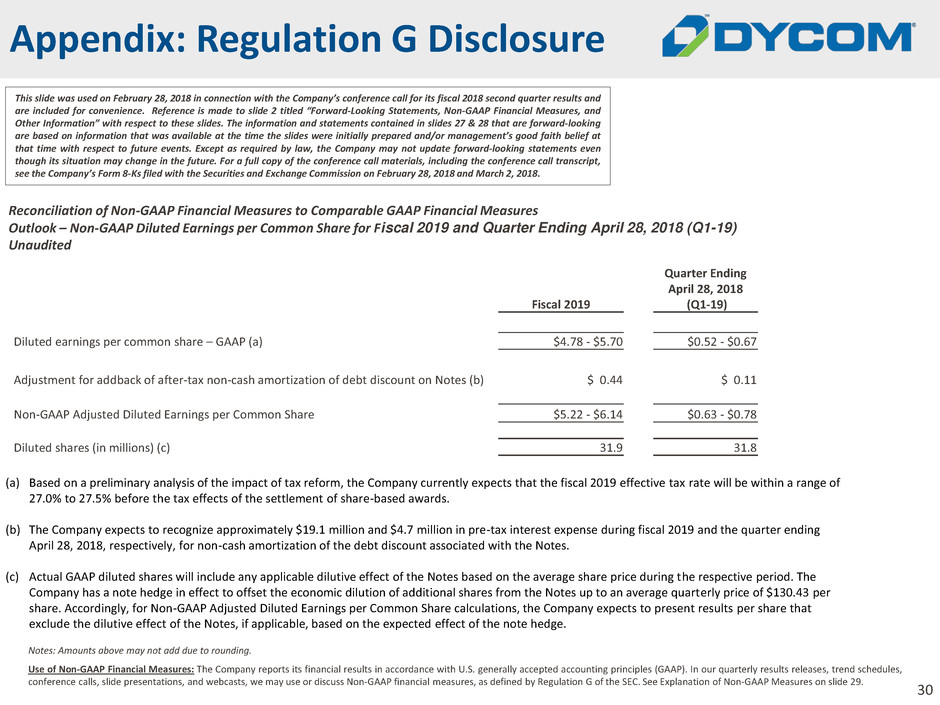
30
Appendix: Regulation G Disclosure
This slide was used on February 28, 2018 in connection with the Company’s conference call for its fiscal 2018 second quarter results and
are included for convenience. Reference is made to slide 2 titled “Forward-Looking Statements, Non-GAAP Financial Measures, and
Other Information” with respect to these slides. The information and statements contained in slides 27 & 28 that are forward-looking
are based on information that was available at the time the slides were initially prepared and/or management’s good faith belief at
that time with respect to future events. Except as required by law, the Company may not update forward-looking statements even
though its situation may change in the future. For a full copy of the conference call materials, including the conference call transcript,
see the Company’s Form 8-Ks filed with the Securities and Exchange Commission on February 28, 2018 and March 2, 2018.
Use of Non-GAAP Financial Measures: The Company reports its financial results in accordance with U.S. generally accepted accounting principles (GAAP). In our quarterly results releases, trend schedules,
conference calls, slide presentations, and webcasts, we may use or discuss Non-GAAP financial measures, as defined by Regulation G of the SEC. See Explanation of Non-GAAP Measures on slide 29.
Notes: Amounts above may not add due to rounding.
Reconciliation of Non-GAAP Financial Measures to Comparable GAAP Financial Measures
Outlook – Non-GAAP Diluted Earnings per Common Share for Fiscal 2019 and Quarter Ending April 28, 2018 (Q1-19)
Unaudited
Fiscal 2019
Quarter Ending
April 28, 2018
(Q1-19)
Diluted earnings per common share – GAAP (a) $4.78 - $5.70 $0.52 - $0.67
Adjustment for addback of after-tax non-cash amortization of debt discount on Notes (b) $ 0.44 $ 0.11
Non-GAAP Adjusted Diluted Earnings per Common Share $5.22 - $6.14 $0.63 - $0.78
Diluted shares (in millions) (c) 31.9 31.8
(a) Based on a preliminary analysis of the impact of tax reform, the Company currently expects that the fiscal 2019 effective tax rate will be within a range of
27.0% to 27.5% before the tax effects of the settlement of share-based awards.
(b) The Company expects to recognize approximately $19.1 million and $4.7 million in pre-tax interest expense during fiscal 2019 and the quarter ending
April 28, 2018, respectively, for non-cash amortization of the debt discount associated with the Notes.
(c) Actual GAAP diluted shares will include any applicable dilutive effect of the Notes based on the average share price during the respective period. The
Company has a note hedge in effect to offset the economic dilution of additional shares from the Notes up to an average quarterly price of $130.43 per
share. Accordingly, for Non-GAAP Adjusted Diluted Earnings per Common Share calculations, the Company expects to present results per share that
exclude the dilutive effect of the Notes, if applicable, based on the expected effect of the note hedge.
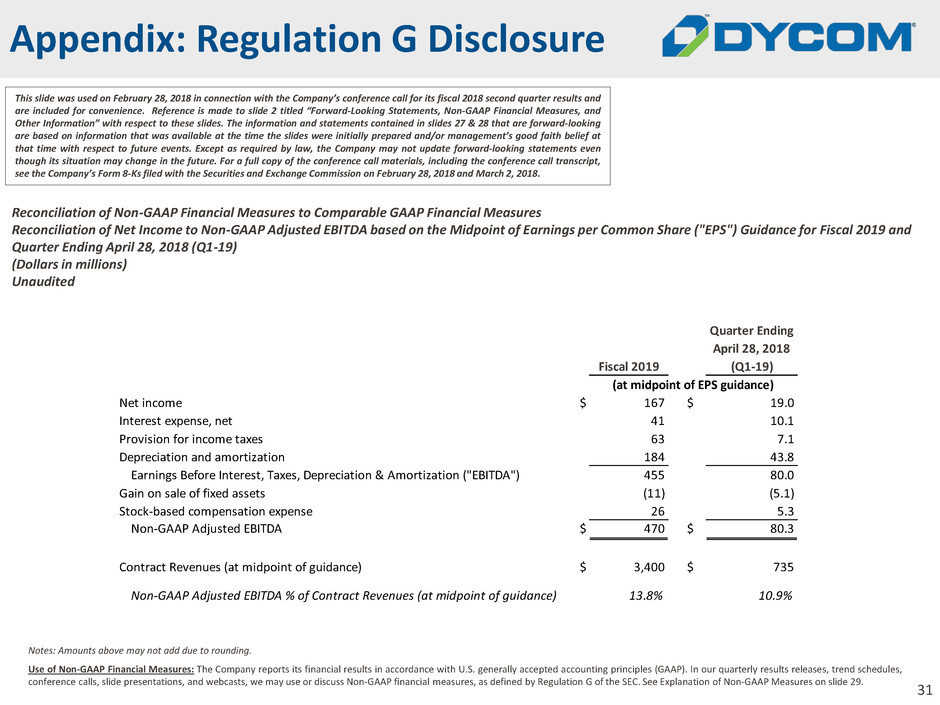
31
Appendix: Regulation G Disclosure
This slide was used on February 28, 2018 in connection with the Company’s conference call for its fiscal 2018 second quarter results and
are included for convenience. Reference is made to slide 2 titled “Forward-Looking Statements, Non-GAAP Financial Measures, and
Other Information” with respect to these slides. The information and statements contained in slides 27 & 28 that are forward-looking
are based on information that was available at the time the slides were initially prepared and/or management’s good faith belief at
that time with respect to future events. Except as required by law, the Company may not update forward-looking statements even
though its situation may change in the future. For a full copy of the conference call materials, including the conference call transcript,
see the Company’s Form 8-Ks filed with the Securities and Exchange Commission on February 28, 2018 and March 2, 2018.
Use of Non-GAAP Financial Measures: The Company reports its financial results in accordance with U.S. generally accepted accounting principles (GAAP). In our quarterly results releases, trend schedules,
conference calls, slide presentations, and webcasts, we may use or discuss Non-GAAP financial measures, as defined by Regulation G of the SEC. See Explanation of Non-GAAP Measures on slide 29.
Notes: Amounts above may not add due to rounding.
Reconciliation of Non-GAAP Financial Measures to Comparable GAAP Financial Measures
Reconciliation of Net Income to Non-GAAP Adjusted EBITDA based on the Midpoint of Earnings per Common Share ("EPS") Guidance for Fiscal 2019 and
Quarter Ending April 28, 2018 (Q1-19)
(Dollars in millions)
Unaudited
Fiscal 2019
Quarter Ending
April 28, 2018
(Q1-19)
Net income $ 167 $ 19.0
Interest expense, net 41 10.1
Provision for income taxes 63 7.1
D pre iatio and amortization 184 43.8
Ear i Before Interest, Taxes, Depreciation & Amortization ("EBITDA") 455 80.0
in on sal f fixed assets (11) (5.1)
Stock-based compensation expense 26 5.3
Non-GAAP Adjusted EBITDA $ 470 $ 80.3
Contract Revenues (at midpoint of guidance) $ 3,400 $ 735
Non-GAAP Adjusted EBITDA % of Contract Revenues (at midpoint of guidance) 13.8% 10.9%
(at midpoint of EPS guidance)
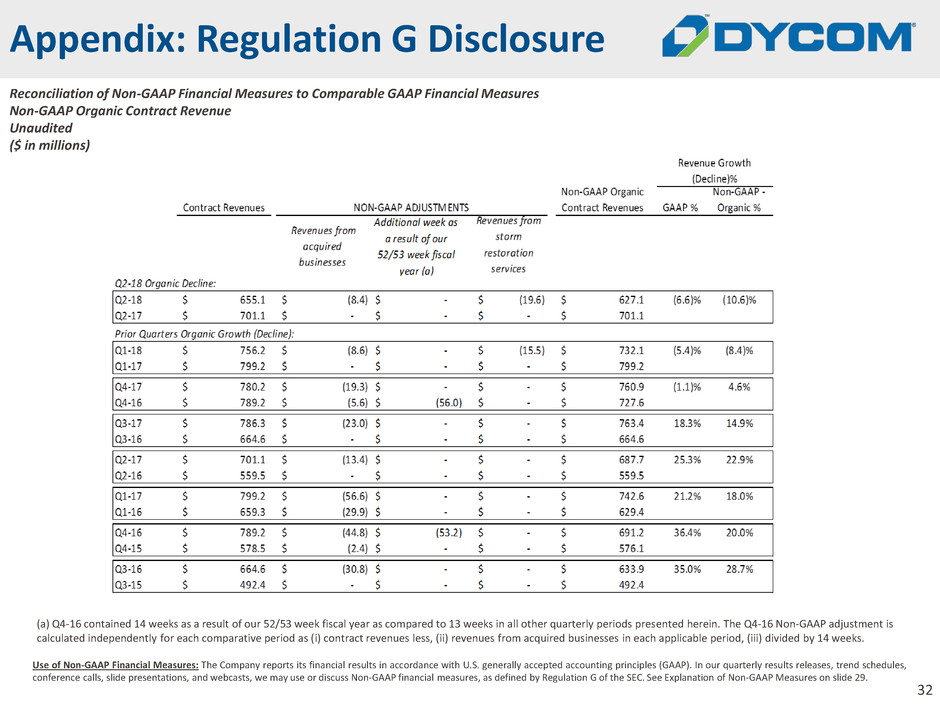
32
Appendix: Regulation G Disclosure
Reconciliation of Non-GAAP Financial Measures to Comparable GAAP Financial Measures
Non-GAAP Organic Contract Revenue
Unaudited
($ in millions)
(a) Q4-16 contained 14 weeks as a result of our 52/53 week fiscal year as compared to 13 weeks in all other quarterly periods presented herein. The Q4-16 Non-GAAP adjustment is
calculated independently for each comparative period as (i) contract revenues less, (ii) revenues from acquired businesses in each applicable period, (iii) divided by 14 weeks.
Use of Non-GAAP Financial Measures: The Company reports its financial results in accordance with U.S. generally accepted accounting principles (GAAP). In our quarterly results releases, trend schedules,
conference calls, slide presentations, and webcasts, we may use or discuss Non-GAAP financial measures, as defined by Regulation G of the SEC. See Explanation of Non-GAAP Measures on slide 29.

33
(a) Non-GAAP adjustments in FY 2016 reflect adjustments in Q4-16 resulting from the Company’s 52/53 week fiscal year. The Q4-16 Non-GAAP adjustment is calculated independently
for each comparative period as (i) contract revenues less, (ii) revenues from acquired businesses in each applicable period, (iii) divided by 14 weeks.
(b) Revenue for the 4 Quarters Ended January 28, 2017 is calculated as the aggregate of $664.6 million in Q3-16, $789.2 million in Q4-16, $799.2 million in Q1-17, and $701.1 million in
Q2-17.
Contract Revenues and Organic Growth - Reconciliation of GAAP to Non-GAAP Measures ($ in millions)
The table below reconciles GAAP revenue growth to Non-GAAP organic revenue growth
Appendix: Regulation G Disclosure
Notes: Amounts above may not add due to rounding.
Use of Non-GAAP Financial Measures: The Company reports its financial results in accordance with U.S. generally accepted accounting principles (GAAP). In our quarterly results releases, trend schedules,
conference calls, slide presentations, and webcasts, we may use or discuss Non-GAAP financial measures, as defined by Regulation G of the SEC. See Explanation of Non-GAAP Measures on slide 29.
Revenues from
acquired
businesses
Revenues from
storm restoration
services
Additional week
as a result of our
52/53 week fiscal
year (a) GAAP %
Non-GAAP -
Organic %
4 Quarters Ended January 27, 2018 2,977.9$ (87.3)$ (35.1)$ -$ 2,855.5$ 0.8% (0.2)%
4 Quarters Ended January 28, 2017 (b) 2,954.2$ (37.3)$ -$ (56.0)$ 2,860.9$
Fiscal 2017 3,066.9$ (214.9)$ -$ -$ 2,852.0$ 14.8% 14.1%
Fiscal 2016 2,672.5$ (119.8)$ -$ (53.5)$ 2,499.2$
Fiscal 2016 2,672.5$ (159.0)$ -$ (52.9)$ 2,460.7$ 32.2% 22.7%
Fiscal 2015 2,022.3$ (17.7)$ -$ -$ 2,004.7$
Fi a 2015 2,022.3$ (40.4)$ -$ -$ 1,982.0$ 11.6% 9.6%
Fiscal 2014 1,811.6$ (2.8)$ -$ -$ 1,808.8$
Fiscal 2014 1,811.6$ (499.3)$ -$ -$ 1,312.3$ 12.6% 4.7%
Fiscal 2013 1,608.6$ (337.9)$ (16.7)$ -$ 1,254.0$
Fiscal 2013 1,608.6$ (337.9)$ (16.7)$ -$ 1,254.0$ 33.9% 4.9%
Fiscal 2012 1,201.1$ -$ (6.0)$ -$ 1,195.1$
GAAP Contract
Revenues
NON-GAAP ADJUSTMENTS
Non-GAAP -
Organic Contract
Revenues
Revenue Growth (Decline)%
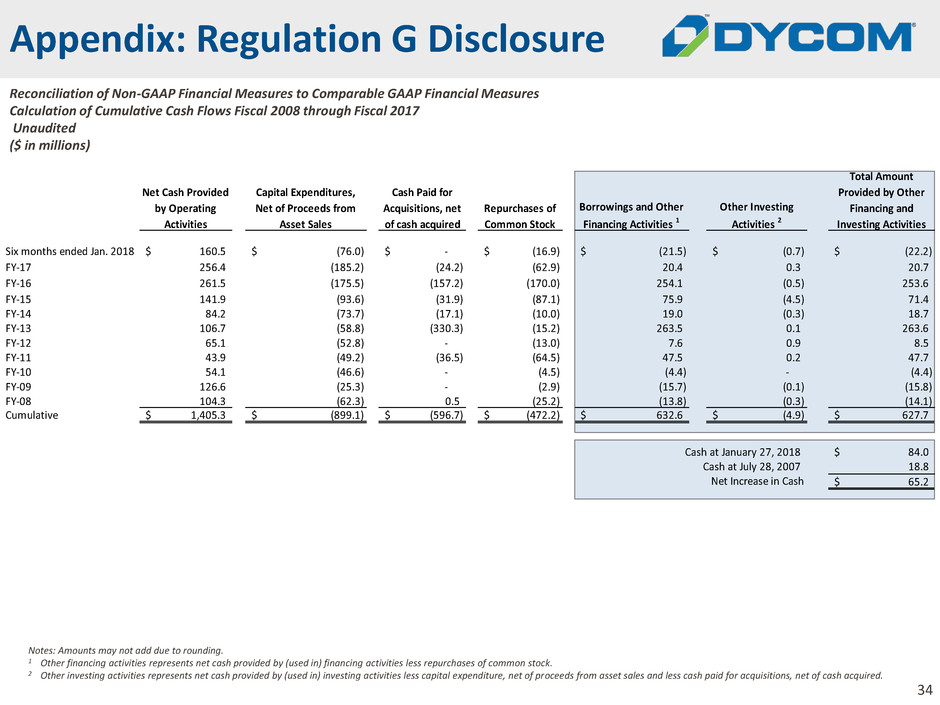
34
Notes: Amounts may not add due to rounding.
1 Other financing activities represents net cash provided by (used in) financing activities less repurchases of common stock.
2 Other investing activities represents net cash provided by (used in) investing activities less capital expenditure, net of proceeds from asset sales and less cash paid for acquisitions, net of cash acquired.
Reconciliation of Non-GAAP Financial Measures to Comparable GAAP Financial Measures
Calculation of Cumulative Cash Flows Fiscal 2008 through Fiscal 2017
Unaudited
($ in millions)
Appendix: Regulation G Disclosure
Net Cash Provided
by Operating
Activities
Capital Expenditures,
Net of Proceeds from
Asset Sales
Cash Paid for
Acquisitions, net
of cash acquired
Repurchases of
Common Stock
Borrowings and Other
Financing Activities 1
Other Investing
Activities 2
Total Amount
Provided by Other
Financing and
Investing Activities
Six months ended Jan. 2018 160.5$ (76.0)$ -$ (16.9)$ (21.5)$ (0.7)$ (22.2)$
FY-17 256.4 (185.2) (24.2) (62.9) 20.4 0.3 20.7
FY-16 261.5 (175.5) (157.2) (170.0) 254.1 (0.5) 253.6
FY-15 141.9 (93.6) (31.9) (87.1) 75.9 (4.5) 71.4
FY-14 84.2 (73.7) (17.1) (10.0) 19.0 (0.3) 18.7
FY-13 106.7 (58.8) (330.3) (15.2) 263.5 0.1 263.6
FY-12 65.1 (52.8) - (13.0) 7.6 0.9 8.5
FY-11 43.9 (49.2) (36.5) (64.5) 47.5 0.2 47.7
FY-10 54.1 (46.6) - (4.5) (4.4) - (4.4)
FY-09 126.6 (25.3) - (2.9) (15.7) (0.1) (15.8)
FY-08 104.3 (62.3) 0.5 (25.2) (13.8) (0.3) (14.1)
Cumulative 1,405.3$ (899.1)$ (596.7)$ (472.2)$ 632.6$ (4.9)$ 627.7$
84.0$
18.8
65.2$
Cash at January 27, 2018
Cash at July 28, 2007
Net Increase in Cash

35
(a) During the quarter ended January 27, 2018, the Company recognized an income tax benefit of approximately $32.2 million resulting from the Tax Cuts and Jobs Act of 2017 (“Tax Reform”), primarily
due to the re-measurement of the Company’s net deferred tax liabilities at a lower U.S. federal corporate income tax rate.
(b) During the quarter ended January 27, 2018, the Company recognized an income tax benefit of approximately $6.9 million for the tax effects of the vesting and exercise of share-based awards.
(c) The Company has a note hedge in effect to offset the economic dilution of additional shares from the Notes up to an average quarterly share price of $130.43 per share. Non-GAAP Adjusted Diluted
Shares excludes the GAAP dilutive effect of the Notes.
Reconciliation of Non-GAAP Financial Measures to Comparable GAAP Financial Measures
Non-GAAP Adjusted Net Income, Non-GAAP Adjusted Diluted EPS, and Non-GAAP Adjusted Interest Expense
Unaudited ($ in 000's, except per share amounts)
Appendix: Regulation G Disclosure
Use of Non-GAAP Financial Measures: The Company reports its financial results in accordance with U.S. generally accepted accounting principles (GAAP). In our quarterly results releases, trend schedules,
conference calls, slide presentations, and webcasts, we may use or discuss Non-GAAP financial measures, as defined by Regulation G of the SEC. See Explanation of Non-GAAP Measures on slide 29.
Notes: Amounts above may not add due to rounding.
Reconciliation of Net Income to Non-GAAP Adjusted Net Income and Diluted EPS to Non-GAAP Adjusted Diluted EPS
Fiscal 2013 Fiscal 2014 Fiscal 2015 Q1-16 Q2-16 Q3-16 Q4-16 Fiscal 2016 Q1-17 Q2-17 Q3-17 Q4-17 Fiscal 2017 Q1-18 Q2-18
4 Qtrs. Ended
Jan 27, 2018
Net income 35.2$ 40.0$ 84.3$ 30.8$ 15.5$ 33.1$ 49.4$ 128.7$ 51.1$ 23.7$ 38.8$ 43.7$ 157.2$ 28.8$ 40.1$ 151.3$
Loss on debt extinguishment - - - 16.3 - - - 16.3 - - - - - - - -
Amortization of debt discount - - - 1.8 4.1 4.2 4.6 14.7 4.3 4.4 4.4 4.5 17.6 4.5 4.6 18.1
Charges for settlement of wage and hour litigation 0.5 0.6 - - - - - - - - - - - - - -
Acquisition related costs 6.8 - - - - - 0.7 0.7 - - - - - - - -
Tax impact of adjustments (3.0) (0.2) - (6.8) (1.6) (1.6) (2.0) (12.0) (1.6) (1.6) (1.6) (1.7) (6.6) (1.7) (1.8) (6.8)
Tax impact of Tax Reform (a) - - - - - - - - - - - - - - (32.2) (32.2)
Tax impact of share-based vestings and exercises (b) - - - - - - - - - - - - - - (6.9) (6.9)
Total adjustments, net of tax 4.6$ 0.4$ -$ 11.2$ 2.5$ 2.6$ 3.3$ 19.6$ 2.7$ 2.7$ 2.8$ 2.8$ 11.0$ 2.8$ (36.3)$ (27.9)$
Non-GAAP Adjusted Net income 39.8$ 40.3$ 84.3$ 42.0$ 18.0$ 35.7$ 52.7$ 148.3$ 53.7$ 26.4$ 41.6$ 46.5$ 168.3$ 31.6$ 3.8$ 123.5$
Dilut Ea ings Per Share
Net income 1.04$ 1.15$ 2.41$ 0.91$ 0.46$ 1.00$ 1.54$ 3.89$ 1.59$ 0.74$ 1.22$ 1.38$ 4.92$ 0.90$ 1.24$ 4.74$
Adjusting Items from above, after tax 0.14 0.01 - 0.33 0.08 0.08 0.10 0.59 0.08 0.09 0.09 0.09 0.35 0.09 (1.12) (0.86)
Non-GAAP Adjusted Diluted Earnings Per Common Share 1.18$ 1.16$ 2.41$ 1.24$ 0.54$ 1.08$ 1.64$ 4.48$ 1.67$ 0.82$ 1.30$ 1.47$ 5.26$ 0.99$ 0.12$ 3.88$
GAAP Fully Diluted Shares (in thousands) 33,782 34,816 35,027 33,887 33,520 33,051 32,074 33,116 32,200 32,162 31,910 31,664 31,985 31,892 32,218 31,921
Adjustment for economic benefit of note hedge related to Notes (c) - - - - - - - - - - - - - - (435) (109)
Non-GAAP Adjusted Fully Diluted Shares (in thousands) (c) 33,782 34,816 35,027 33,887 33,520 33,051 32,074 33,116 32,200 32,162 31,910 31,664 31,985 31,892 31,784 31,813

36
Appendix: Regulation G Disclosure
Reconciliation of Non-GAAP Financial Measures to Comparable GAAP Financial Measures
Non-GAAP Adjusted EBITDA
Unaudited ($ in 000's, except per share amounts)
Use of Non-GAAP Financial Measures: The Company reports its financial results in accordance with U.S. generally accepted accounting principles (GAAP). In our quarterly results releases, trend schedules,
conference calls, slide presentations, and webcasts, we may use or discuss Non-GAAP financial measures, as defined by Regulation G of the SEC. See Explanation of Non-GAAP Measures on slide 29.
Notes: Amounts above may not add due to rounding.
Reconciliation of Net Income to Non-GAAP Adjusted EBITDA
Fiscal 2013 Fiscal 2014 Fiscal 2015 Q1-16 Q2-16 Q3-16 Q4-16 Fiscal 2016 Q1-17 Q2-17 Q3-17 Q4-17 Fiscal 2017 Q1-18 Q2-18
4 Qtrs. Ended
Jan 27, 2018
Net income 35.2$ 40.0$ 84.3$ 30.8$ 15.5$ 33.1$ 49.4$ 128.7$ 51.1$ 23.7$ 38.8$ 43.7$ 157.2$ 28.8$ 40.1$ 151.3$
Provision (benefit) for income taxes 23.0 26.3 51.3 18.6 10.0 19.4 29.6 77.6 30.3 14.0 22.7 26.1 93.2 15.6 (37.9) 26.6
Interest expense, net 23.3 26.8 27.0 9.1 7.9 8.0 9.7 34.7 9.1 9.2 9.4 9.7 37.4 9.7 9.9 38.7
Depreciation 64.8 74.5 79.3 22.7 25.2 27.0 30.6 105.5 28.4 29.6 31.2 34.0 123.1 36.4 36.6 138.1
Amortization 20.7 18.3 16.7 4.8 4.7 4.5 5.4 19.4 6.2 6.1 6.2 6.3 24.8 6.3 5.8 24.6
EBITDA 167.0 185.9 258.7 86.0 63.2 92.0 124.7 366.0 125.0 82.6 108.3 119.8 435.7 96.7 54.4 379.3
Gain on sale of fixed assets (4.7) (10.7) (7.1) (1.1) (1.0) (4.1) (3.6) (9.8) (1.4) (1.7) (5.0) (6.6) (14.9) (6.5) (0.7) (18.9)
Stock-based compensation expense 9.9 12.6 13.9 4.5 4.2 3.9 4.2 16.9 5.7 5.3 4.9 4.9 20.8 7.3 5.9 23.1
Loss on debt extinguishment - - - 16.3 - - - 16.3 - - - - - - - -
Acquisition related costs 6.8 - - - - - 0.7 0.7 - - - - - - - -
Charges f r settlement of wage and hour litigation 0.5 0.6 - - - - - - - - - - - - - -
Non-G AP Adjusted EBITDA 179.8$ 188.4$ 265.5$ 105.7$ 66.4$ 91.9$ 126.0$ 390.0$ 129.2$ 86.2$ 108.2$ 118.0$ 441.6$ 97.6$ 59.6$ 383.5$
Reconciliation of Non-GAAP Adjusted EBITDA (from above) as a % of Revenue
Fiscal 2013 Fiscal 2014 Fiscal 2015 Q1-16 Q2-16 Q3-16 Q4-16 Fiscal 2016 Q1-17 Q2-17 Q3-17 Q4-17 Fiscal 2017 Q1-18 Q1-18
4 Qtrs. Ended
Jan 27, 2018
Total contract revenues 1,608.6$ 1,811.6$ 2,022.3$ 659.3$ 559.5$ 664.6$ 789.2$ 2,672.5$ 799.2$ 701.1$ 786.3$ 780.2$ 3,066.9$ 756.2$ 655.1$ 2,977.9$
EBITDA as a percentage of contract revenues 10.4% 10.3% 12.8% 13.1% 11.3% 13.8% 15.8% 13.7% 15.6% 11.8% 13.8% 15.4% 14.2% 12.8% 8.3% 12.7%
Non-GAAP Adjusted EBITDA as a % of contract revenues 11.2% 10.4% 13.1% 16.0% 11.9% 13.8% 16.0% 14.6% 16.2% 12.3% 13.8% 15.1% 14.4% 12.9% 9.1% 12.9%

Investor
Presentation
March 2018
Serious News for Serious Traders! Try StreetInsider.com Premium Free!
You May Also Be Interested In
- Electrolit Renews Partnership with Patricio "Pato" O'Ward, Extending Sponsorship for Third Consecutive Year
- UBS hires financial advisor team led by Christopher Toregas in Los Angeles
- ROSEN, TRUSTED INVESTOR COUNSEL, Encourages The Chemours Company Investors to Secure Counsel Before Important Deadline in Securities Class Action – CC
Create E-mail Alert Related Categories
SEC FilingsSign up for StreetInsider Free!
Receive full access to all new and archived articles, unlimited portfolio tracking, e-mail alerts, custom newswires and RSS feeds - and more!



 Tweet
Tweet Share
Share